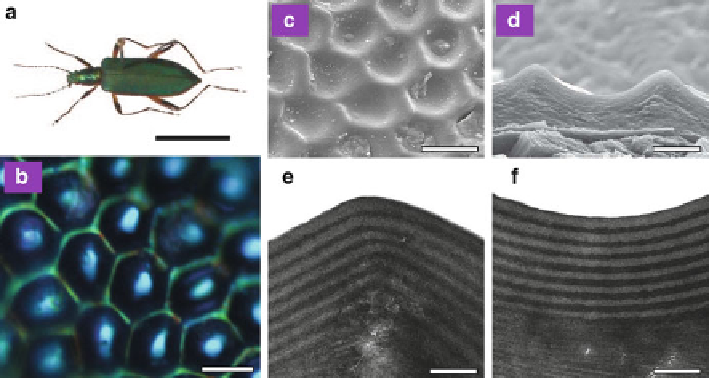Biomedical Engineering Reference
In-Depth Information
Fig. 8.19
(
a
) Optical image of a male beetle
C. obscuripennis
. Its elytra display an inconspicuous
iridescent blueish green color. (
b
) Optical microscopic image of an elytron under 1,000
magnification. (
c
) SEM top view of the outer elytral surface. The elytral surface is composed
of an array of hexagonal pits. (
d
) Transverse SEM cross-section of the outermost elytra surface.
(
e
)and(
f
) Transverse TEM cross-sections of the ridge and basin regions, respectively. Scale bars:
(
a
)1cm;(
b
)5
m; (
c
)10
m; (
d
)5
m; and (
e
)and(
f
)0.5
m (Reproduced from [
96
])
special form of multilayers in the biological world, sculpted multilayers [
93
-
95
]that
can produce structural colors different in many ways from those in flat multilayers,
e.g., inconspicuous structural coloration. The adoption of an inconspicuous green
color by sculpted multilayers may be more advantageous for camouflage against
green backgrounds [
94
,
95
], especially on diffuse leafy surfaces.
Sculpted multilayers found for the first time might be those in the elytra of tiger
beetles (Carabidae: Cicindelinae) [
93
]. The elytral surfaces are in the form of a
hexagonal array of pits, and the multilayer in the elytra conforms with the profile of
the pits in a sculpted way. The reflecting sculpted multilayer at the basins and ridges
possesses different periods and hence cause different structural colors, leading to
“pointillistic” color mixing.
A similar sculpted multilayer occurs also in the beetle
Chlorophila obscuripennis
(Coleoptera) [
96
], as shown in Fig.
8.19
. Unlike other beetles, this beetle shows a
very inconspicuous iridescent blueish green color. The SEM top-view image shows
that the outer surface of the elytra is not flat; instead, it comprises an array of
hexagonal pits. Compared with the optical microscopic images, there exists an exact
correspondence between the surface morphology and the observed color pattern:
the pit ridges produce a green color, the basins a cyan color, and the inclined
sides a dull blue color. All these colors change with the viewing angle. From the
transverse cross-sectional images, the pits are about 11
m in size and about 2.8
m in depth. From TEM images, the sculpted multilayer consists of about 16 thin
layers with alternating low and high electron densities, which are the cause of

